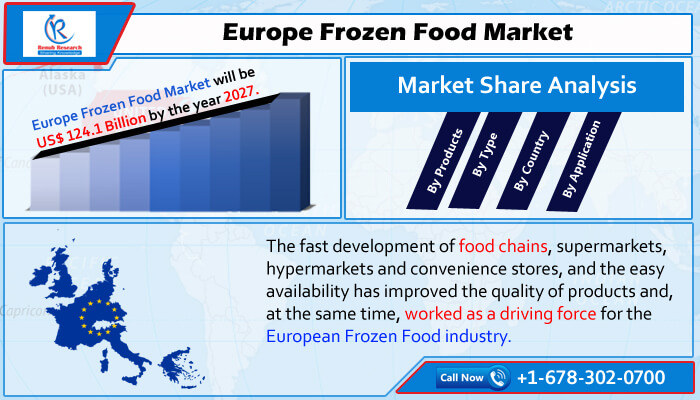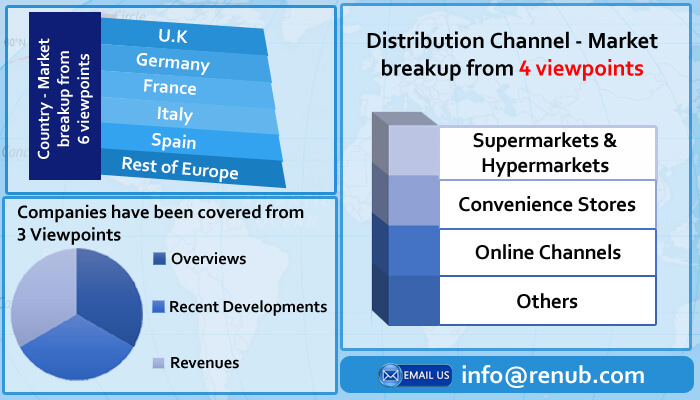Europe Frozen Food Market is Forecasted to be more than 124.1 Billion by the end of year 2027
25 Oct, 2021
Frozen foods are foods stored at low temperatures and used for an extended period. Although used as a preservation method for a long time in the colder regions, frozen foods became a staple diet. The popularity of frozen foods in Europe is also linked with the increasing popularity of refrigerators in the twentieth century. With the increasingly hectic lifestyle and growing need for convenient food, frozen food has witnessed a wide adoption through the twenty-first century. In particular, evolved urban and regional sectors have played an essential role in popularizing this trend. According to the latest report by Renub Research, Europe Frozen Food Market is expected to be an USD 124.1 Billion opportunity by 2027.

By Product Category, the European Frozen Food Market consists of Raw Materials, Half-Cooked and Ready-To-Eat. Ready-to-eat frozen foods include packaged bakeries, snacks, ready-to-eat foods, and desserts. People residing in Europe, away from home, are actively looking for a variety of frozen foods and ready-to-cook meal options. Commercial consumers such as caterers, restaurants, hotels, and fast-food chains are among the top users of frozen vegetables and frozen foods, including the objective of frozen foods to aid the cooking process and elongate the shelf life. It is considered an imperative component of the meals cooked and served by homes and restaurants. The overall distribution channel development is also available in European Frozen Food Market.
Covid-19 has been a Significant Contributor to European Frozen Food Market
A series of trends have helped sustain the growth of the frozen category in the European market. Covid-19 has been a significant contributor to this growth as people gravitate towards foods with longer shelf lives. Indeed, the sudden outbreak of COVID-19 had increased the sales of frozen food products in 2020, which slightly slumped in the following year, i.e., 2021, but in the year beyond, the market, will keep flourishing.
In the coming years, post-pandemic, time outside of a career, commuting, socializing, and family is expected to be hard to come by. Hence, Europeans are constantly drifting towards ways to reduce meal preparation time without sacrificing the quality of the food. Consequently, consumers will be looking for ‘co-creation frozen offerings that remain convenient.
European Frozen Food Market Size was estimated at US$ 87.3 Billion in 2020
By Product type, there are diverse types of frozen foods available, and the quick transitions in consumer consumption practices will lead many consumers to adopt European Frozen Food. As per our analysis, the produce market consists of various food products such as frozen ready meals, frozen fish and seafood, frozen meat and poultry and frozen fruits and vegetables. In addition, increased consumer spending on cold-stored food is expected to expand the European Frozen Food market in the near future. Thereon, frozen fruits and vegetables are popular among European people owing to the increasing consumer choice towards frozen fruits and vegetables, which usually have more vitamins and minerals than fresh, because fresh produce succumbs vitamins and minerals over time while freezing preserves them.

Germany, United Kingdom & Spain are driving the Frozen Food Industry of Europe
As per our analysis, we have covered markets of the U.K, Germany, France, Italy, and Spain by the country. In Europe, the German frozen food market is estimated to be a significant growth engine. The booming consumption of frozen meat and seafood is stimulating the growth of the German frozen food market. Furthermore, consumption of frozen food in the UK region has increased tremendously due to improved living standards. The transformation to a more comfortable lifestyle is majorly influencing the demand of the UK frozen food market. Similarly, in Spain, strict government regulations to maintain product quality and certifications/labels and make products more attractive strengthen the frozen food market growth.
Europe Frozen Food Industry will grow with a CAGR of 5.15% during 2020-2027
By Distribution Channel, the fast development of hypermarkets, supermarkets, convenience stores, discount, online channels and speciality stores, and the easy availability and improved quality of products are some of the significant drivers of the European Frozen Food Industry. Numerous manufacturers are adopting innovative strategies and technological shifts to reduce the loss of nutrients in frozen foods and reduce harmful plastic packaging to meet the growing demand of Europe for Frozen Food. Major Key Players in the European Frozen Food Market are General Mills, Kellogg’s Company, Unilever and Nestle.
Reach out to us
Call us on
USA: +1-678-302-0700
INDIA: +91-120-421-9822
Drop us an email at
info@renub.com